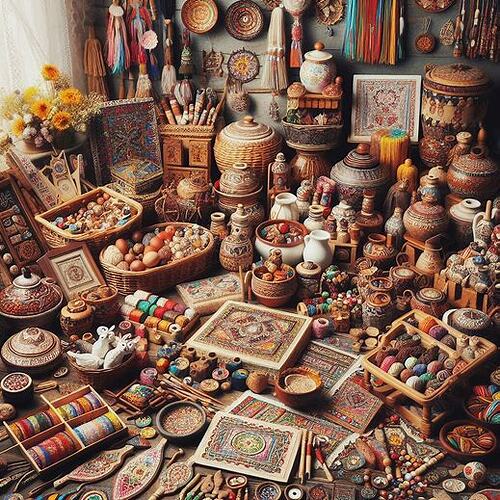Handicrafts in Afghanistan
Handicrafts in Afghanistan are an important part of the country’s culture, history, and economy, and are world-renowned for their artistic skills and unique beauty. Below are some of the famous handicrafts of Afghanistan:
1. Carpet weaving
Afghan carpets are famous for their high quality, beautiful designs and natural colors. These carpets are mostly made using wool and natural dyes, and each region has its own designs and patterns, such as Balkh, Herat and Kandahar carpets.
2. Embroidery and cream embroidery
Khamakdozi is one of the traditional arts of Afghan women, which is more common in southern regions such as Kandahar and Helmand. This art includes sewing beautiful designs on clothes and fabrics.
3. Goldsmithing and jewelry making
Afghanistan has rich reserves of precious stones such as lapis lazuli, emeralds and rubies. The art of goldsmithing in Afghanistan includes designing and making beautiful ornaments from these stones, which are mostly seen in Badakhshan and northern regions.
4. Pottery and pottery making
In cities like Herat and Ghazni, the art of pottery is still alive. Dishes and decorative objects made of clay are known for their traditional designs and beautiful patterns.
5. Leather embroidery
The art of leather embroidery is common in Afghanistan for making leather products such as bags, shoes, and belts. These products are often known for their high quality and durability.
6. Glazing
Herat is one of the main centers of glass making art in Afghanistan. The glasses produced in this region are famous for their various colors and beautiful designs.
7. Woodworking
The art of woodworking is used in making furniture, decorative doors and windows, and ornamental objects. Cities like Kabul and Kandahar are famous in this field.
8. Metalworking and coppersmithing
Copper and metal dishes that are carefully carved are other famous handicrafts of Afghanistan. This art is more common in the cities of Herat, Kabul and Kandahar.
The importance of handicrafts
Handicrafts are not only an expression of the cultural identity of the Afghan people, but also an important source of employment and income, especially for women and rural families. Considering the country’s economic challenges, supporting these arts can help economic development.
Benefits of crafts
Handicrafts are not only a manifestation of the art and culture of a nation, but also have wide economic, social, cultural and even environmental benefits. Below are some of the most important benefits of handicrafts:
1. Economic benefits
• Employment generation: Handicrafts provide employment opportunities to many people, especially women and rural communities.
• Local economic development: By selling local products in domestic and foreign markets, sustainable income is provided to communities.
• Attracting tourism: Handicrafts are one of the factors that attract tourists, which causes the growth of the tourism industry and increase in income.
• Earning foreign exchange: exporting handicrafts to world markets can help to provide foreign currency.
2. Social benefits
• Strengthening local identity: handicrafts reflect local traditions and culture and help to strengthen the sense of identity among people.
• Empowerment of women: Many handicrafts are produced by women, which helps to empower them in society.
• Strengthening social relations: The production of handicrafts is often done in groups and in workshop environments, which strengthens social relations in society.
3. Cultural benefits
• Preservation of cultural heritage: handicrafts are a means of preserving and transferring traditional knowledge and skills to future generations.
• Promotion of art and aesthetics: handicrafts represent the taste and art of artists that promote the culture of aesthetics in the society.
• Reflection of history and national identity: The designs and roles of handicrafts are a reflection of the history and identity of nations.
4. Environmental benefits
• Use of natural materials: Many handicrafts are made using natural raw materials such as wood, wool, and pottery, which have a less negative impact on the environment.
• Sustainability and recycling: Many handicraft products can be recycled or are made from recycled materials.
• Reduction of pollution: compared to industrial production, handicraft production consumes less energy and causes less pollution.
5. Educational and psychological benefits
• Skills training: Handicraft production is an opportunity to teach technical and artistic skills to people.
• Strengthening creativity: working in the field of handicrafts strengthens people’s creativity.
• Stress reduction: Doing handicrafts can help reduce stress and improve mental health due to its relaxing nature.

